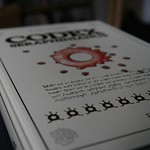Today I was reading a Twitter post by Maria Popova (http://t.co/RdK5JUZsOI) about Luigi Serafini and his encyclopaedia called “Codex Seraphinianus”. The following is the first paragraph from Maria’s post;
“In 1976, Italian artist, architect, and designer Luigi Serafini, only 27 at the time, set out to create an elaborate encyclopedia of imaginary objects and creatures that fell somewhere between Edward Gorey’s cryptic alphabets, Albertus Seba’s cabinet of curiosities, the book of surrealist games, and Alice in Wonderland. What’s more, it wasn’t written in any ordinary language but in an unintelligible alphabet that appeared to be a conlang — an undertaking so complex it constitutes one of the highest feats of cryptography. It took him nearly three years to complete the project, and three more to publish it, but when it was finally released, the book — a weird and wonderful masterpiece of art and philosophical provocation on the precipice of the information age — attracted a growing following that continued to gather momentum even as the original edition went out of print.”
My first reaction on reading this was, “What a brilliant concept!”.
My second reaction was, “Why do we never see such creativity in the corporate office?”
The third reaction was, a repeat of my second reaction, “Why not?”
For a corporate organization to be innovative, it needs to be allowed to think. It’s employees need to be provided with the opportunity to have random, creative thoughts that are not inhibited in any way, but are allowed to run free.
In my blog (https://thinkingfuturethoughts.wordpress.com/) I have written many posts trying to inspire those in the corporate office to think that little bit differently. Yes, some of these posts are a little bit way out, but that’s very much the intention. A previous blog post called “The Room of Thought” typifies some of this thinking; (https://thinkingfuturethoughts.wordpress.com/2013/08/29/the-room-of-thought/)
It’s gratifying to hear that many corporate organizations are now using my blog posts as “thought starters” for their employees, but companies need to do more and strategically embed creativity into their cultural DNA. Unfortunately, for some CEOs, innovation is merely just lip service.
The concept of “Codex Seraphinianus” is a fantastic example in “thinking that little bit differently” and inspires those reading it to open and expand their imagination. It breaks all the traditional rules, which I can only applaud.
Yes, this is my first book review and I give it 4.5 out of 5. Why not 5? Well, the score of 5 has been reserved for your own version of “Codex Seraphinianus” of which you will be the author. This version will I’m sure be a creative masterpiece!




